Ijraset Journal For Research in Applied Science and Engineering Technology
- Home / Ijraset
- On This Page
- Abstract
- Introduction
- Conclusion
- References
- Copyright
Experimental Studies into the Super Finishing of Nitronic-60 by One - Way Extrusion Honing Process
Authors: Sreenivasa Murthy B P, Prasad P, Thimmegowda M B
DOI Link: https://doi.org/10.22214/ijraset.2024.65996
Certificate: View Certificate
Abstract
The surface requirements of engineering components used varies widely depending on where the components surface is being applied for. Fabrication of surfaces with desired characterises on materials possessing high hardness is the need of the hour to effectively overcome the contemporary application challenges. The required surface generation of these difficult to cut material possessing intricate and unable to reach geometries could not be met by conventional finishing processes. So, several non-conventional finishing processes have been developed over the years to meet the ever-growing requirements of the industry, among them, Extrusion Honing or Abrasive Flow Machining where a flexible media loaded with abrasive particles acting as cutting tool can be successfully used to fine finish the surface. In the present study, the abrasive loaded flexible cutting media is extruded using one-way extrusion honing process and the effect of this on the surface characterises of Nitronic-60 is studied. The surface roughness is examined using a stylus type surface measuring instrument and the surface texture of the specimen before and after the process is analysed using SEM images. The results shows a significant enhancement in surface finish using EH/AFM process and the process found quite capable in removing the surface irregularities and producing surface with enhanced overall surface integrity.
Introduction
I. INTRODUCTION
The Extrusion Honing (EH) or Abrasive Flow Machining (AFM) is one of the non-conventional finishing processes developed to improve the surface characteristics of hard materials carrying difficult to reach geometries / shapes. The extrusion honing process consists of machine, tooling and media. The process utilises the visco-elastic property of Silicone polymer and abrading characteristics of abrasive particles coupled together to form a working media and this media is made to pass through the extrusion passage formed by the tooling and workpiece under high pressure. The process can be equated to grinding machining operation. The media passing through the confined space, exerts force onto the workpiece surface and abrades the surface. Thus, the media behaves like grinding tool with abrasives in it as cutting edges. However, the tool in EH remains a flexible one. Through EH/AFM, polishing, de-burring, removing recast layers and to remove stress raisers on the surface.
AFM can able to fine finish surfaces and edges by abrading the surface through concentrated flow of media in one go with great reliability and accuracy producing workpiece with surface characterizes with a phenomenal 90% improvement. It is a most reliable one that can be aptly used to generate required surface finish by altering the process parameters. [1]. Material removed and surface finish achieved under AFM process is mainly influenced by media viscosity and number of strokes affects the material surface where within first few cycles of the process most part of the surface finish is achieved [2]. The effects of AFM on surfaces produced by various machining operations namely; turning, milling, grinding and WEDM. AFM can be compared to conventional grinding operation where all signs of turning and milling found to be removed successfully from the surface, leaving behind only fewer deeper cracks; indicating the superficial nature of machining[3]. Their study had found that, extrusion pressure and concentration of the grains affects the surface finish obtained, where both with high concentration results in active grain density and radial force increases, leading to an increase in percentage reduction of Ra and high material removal [4]. At exit, a bell mouthing surface is generated due to unguided media flow that affects the roundness (form) factor as compared to entry point. The diameter of the hole varies unevenly along the length of the work piece with increasing number of passes revealing uneven material removal [5]. The surface parameters found to be improved rapidly during early phases of honing owing to the removal of dominant surface irregularities, followed by a progressive improvement owing to crest flattening with deterioration of surfaces in later stages.
The out of roundness appears to decrease with AFM process [6-7]. Their experimental studies have shown removal of tool marks and uneven surface lay marks with a uniform lay one along with improved in surface parameters [8-9].
In the current study, extrusion honing operations were performed on Nitronic-60 at laboratory using an indigenously designed and fabricated EH set up. A selected grade polymeric material is used as carrier with silicon carbide (SiC) as abrasives owing to its high hardness have been used in developing media for conducting honing operations. The extruded honed surface of Nitronic-60 have been evaluated for surface finish parameters and the results show positive response.
II. EXPERIMENTATION
The fabrication of hole of required diameter, preparing of working media and precision finishing of hole using a one-way extrusion honing system constitutes the present experimental study. The surface roughness parameters of honed specimens were evaluated after each honing trials and SEM images were used to analyse the effect of honing on surface texture.
A. Work Material details
Super alloy Nitronic-60 is an iron-based high temperature and high strength alloy. The following datasheet provides an overview of super alloy Nitronic-60.
Applications of Nitronic-60
- Automotive valves - can withstand gas temperatures of up to 1500°F for a minimum of 50,000 miles.
- Fastener galling - capable of frequent assembly and disassembly, allowing more use of the fastener before the threads are torn up, also helps to
- Eliminate corroded or frozen fasteners.
- Pins - Used in roller prosthetics & chains to ensure a better fit of parts (closer tolerance, non-lubricated) and longer lasting.
- Marine shafts - better corrosion than types 304 and 316, with double the yield strength.
- Pin and hanger expansion joints for bridges - better corrosion, galling-resistance, low temperature toughness, & high charpoy values at sub-zero temps compared to the A36 and A588 carbon steels commonly used.
TABLE 2.1
Chemical composition of Nitronic-60
|
Element |
Content (%) |
|
Iron, Fe |
58.47 |
|
Nickel, Ni |
8 to 9 |
|
Chromium, Cr |
16 to 18 |
|
Molybdenum, Mo |
0.75 |
|
Manganese, Mn |
7 to 9 |
|
Silicon, Si |
3.5 to 4.5 |
|
Carbon, C |
0.10 |
TABLE 2.2
Physical properties of Nitronic-60
|
Properties |
Metric |
|
Density |
7.6gm/cm3 |
|
Melting point |
1375oC |
TABLE 2.3
Mechanical properties of Nitronic-60
|
Properties |
Metric |
|
Tensile strength |
724MPa |
|
Yield strength |
379MPa |
|
Elongation at break |
35% |
|
Reduction of area |
55% |
|
Hardness, Brinell |
205 |
|
Hardness, Knoop |
330 |
|
Hardness, Rockwell C |
33 |
|
Hardness, Vickers |
318 |
B. Specimen preparation
Nitronic-60 specimens of 25 mm diameter and length 12 mm with hole diameter of 6, 8 and 10 mm. The specimens were initially drilled using carbide drill bits and thoroughly washed with acetone to remove the clogged particles. Surface roughness parameters were measured using a surface roughness measuring instrument (Surfcom 130A) before conducting the experiment.
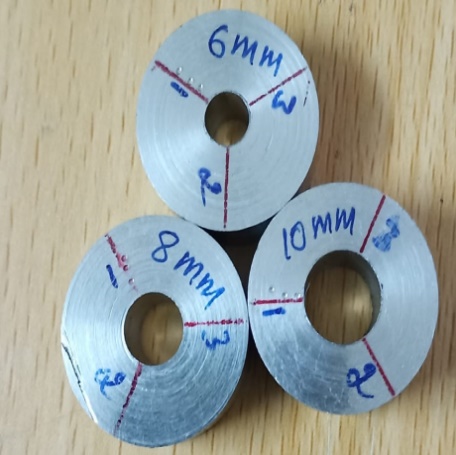
(a)
C. Preparation of Abrasive media
Abrasive media is prepared by thoroughly mixing Silicone carbide abrasives particles with a select grade silicone polymer using abrasive mixer. The volume fraction of Silicone carbide abrasives with silicone polymer used is 50%
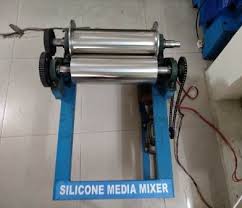
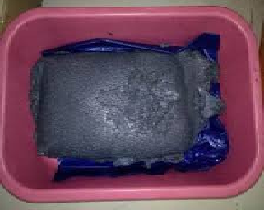
(b) (c)
Fig 2.1: Nitronic 60 specimens (a), Silicone media mixer (b) and abrasive media (c).
D. Experimental Procedure
The extrusion honing machine is switched “on”, the actuation of directional control valve in forward direction results in abrasive media to extrude through the specimen from one side and exits out at the other. After each trails the test specimens were thoroughly cleaned with acetone solution to remove any clogged polymer and other dust particles and surface roughness parameter were measured at 2 locations (drill entry side and drill exit side) each at 3 position (120oC apart). This procedure is repeated for 10 passes and results were tabulated.
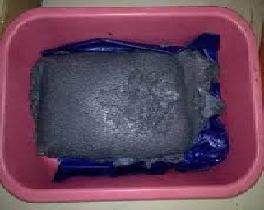
Fig 2.2: Extrusion honing machine
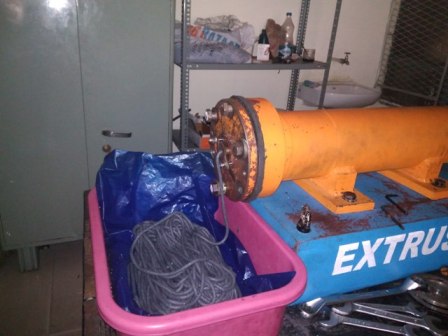
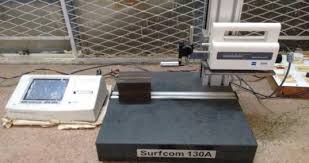
Fig 2.3: Extrusion honing process Fig 2.4: Surface roughness measuring instrument
(Surfcom 130A)
TABLE 2.4
Extrusion Honing Process Parameters
|
Parameters |
Details |
|
Number of passes |
10 |
|
Hole diameter (mm) |
6, 8, 10 |
|
Abrasive mesh size |
36 |
|
Volume fraction of abrasives |
50% |
|
Pressure |
60 bar |
|
Temperature |
Ambient |
|
Stroke length |
600 |
III. RESULTS AND DISCUSSION
The main purpose of this work is to remove surface unevenness and to achieve a fine surface finish by applying extrusion honing process on Nitronic-60. After each finishing process, the honed surface of specimens were evaluated for its surface finish parameters (Ra, Rt, Rz and Rpk). Graphs were plotted for the parameters obtained after each experimental for hole diameter of 6 mm, 8 mm and 10 mm specimens.
A. Observation on surface roughness
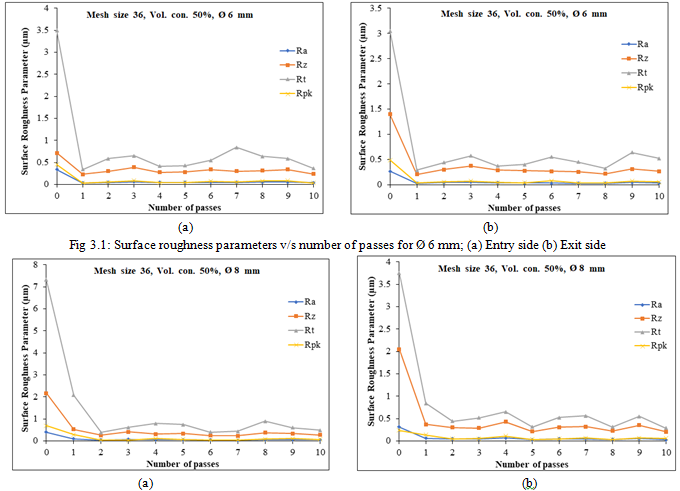
Fig 3.2: Surface roughness parameters v/s number of passes for Ø 8 mm; (a) Entry side (b) Exit side

(a) (b)
Fig 3.3: Surface roughness parameters v/s number of passes for Ø 10 mm; (a) Entry side (b) Exit side
Fig 3.1, 3.2 and 3.3 represents the effects of honing on surface roughness parameters on both entry and exit side respectively. From the corresponding figures, it is observed that, there exhibits a drastic reduction in the surface roughness parameters after 1st pass followed by a progressive reduction afterwards and attains core roughness between 3th to 6th pass, in later passes, surface deterioration sets in.
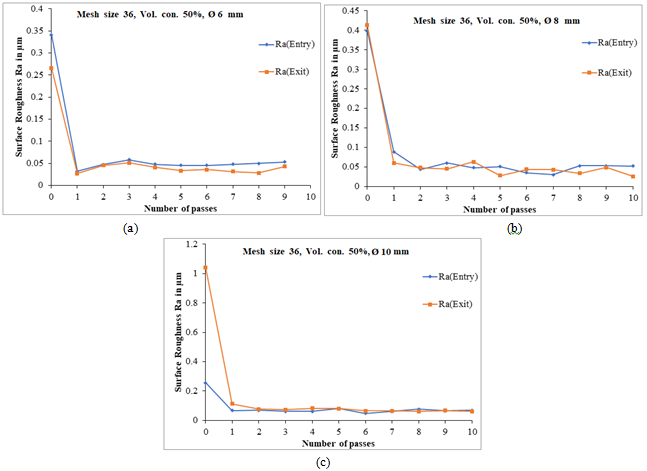
Fig 3.4: Surface roughness (Ra) at Entry and Exit side v/s number of passes; (a) Ø 6 mm, (b) Ø 8 mm and (c) Ø 10 mm
Conclusion
In the current experiment, Extrusion Honing of Nitronic-60 was carried out using a select grade silicone polymer (media) and silicon carbide (SiC) abrasive particles. The extrusion Honed surface of Nitronic-60 were measured at three different locations as mentioned in the experimental procedure on both entry and exit side of the abrasive media flow. From the present experimentation results, following conclusion could be drawn, 1) The present experimental conditions with select grade silicone polymer and SiC abrasives is capable of producing a high surface finish on Nitronic-60 . 2) Surface finish increases substantially after first pass followed by a progressive improvement and once the surface attains core roughness, surface starts to deteriorate. 3) Surface finish of specimen at the exit side of media is better than the entry side. 4) The uneven lay pattern of drilling process has been replaced with a uniform lay as verified in SEM images.
References
[1] L.J. Rhoades, Abrasive flow machining: a case study, Journal of Material Processing Technology 28 (1991) 107–116. [2] R.E. Williams, K.P. Rajurkar, Stochastic modelling and analysis of abrasive flow machining, Transactions of the ASME, Journal of Engineering for Industry 114 (1992) 74–81. [3] T.R. Loveless, R.E. Willams, K.P. Rajurkar, A study of the effects of abrasive flow finishing on various machined surfaces, Journal of Material Processing Technology 47 (1994) 133–151. [4] V.K. Gorana, V.K. Jain, G.K. Lal, On the effect of cutting forces and active grain density on surface roughness in abrasive flow machining, Int. J. Mach. Tool Manuf. 44 (2004) 201–211. [5] J. Kendaa, F. Pusaveca, G. Kermoucheb, J. Kopaca, Surface Integrity in Abrasive Flow Machining of Hardened Tool Steel AISI D2, Procedia Engineering 19 (2011) 172 – 177 [6] Raju H P, Narayanasamy K, Srinivasa Y G and Krishnamurthy R “Characteristics of extrude honed SG iron internal primitives” Journal of Materials Processing Technology 166 (2005), pp 455–464. [7] Devadath, V R, Raju H P, A study of the effect of extrusion honing on Hastealloy c 22 using abrasives of different mesh sizes, international journal of current research in life sciences, Vol, 07, No 02, pp.1029-1035, February,2018. [8] Raju H P, Sreenivasa Murthy B P “Investigation into the Super Finishing of Hole Surface of Titanium Grade-2 using One-Way Extrusion Honing Process” IJRASET, Volume 7, Issue VII, July 2019. [9] Raju H P, Abhijith K S “Studying the Variations of surface Roughness Parameters of Nitronic-60 to Extrusion Honing Process” IJRASET, Volume 7, Issue VII, July 2019.
Copyright
Copyright © 2024 Sreenivasa Murthy B P, Prasad P, Thimmegowda M B. This is an open access article distributed under the Creative Commons Attribution License, which permits unrestricted use, distribution, and reproduction in any medium, provided the original work is properly cited.

Download Paper
Paper Id : IJRASET65996
Publish Date : 2024-12-18
ISSN : 2321-9653
Publisher Name : IJRASET
DOI Link : Click Here
 Submit Paper Online
Submit Paper Online

